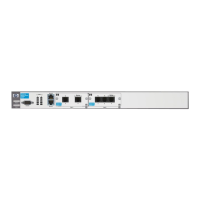8-79
Configuring Demand Routing for Primary ISDN Modules
Quick Start
Quick Start
This section provides the commands you must enter to quickly configure
demand routing for:
■ an ISDN BRI U module
■ an ISDN BRI S/T module
Only a minimal explanation is provided. If you need additional information
about any of these options, check “Contents” on page 8-1 to locate the section
that contains the explanation you need.
When you configure demand routing, you will need to enter information about
your ISDN connection as well as information about the far-end network. You
can use Table 8-18 to record this information before you begin to configure
demand routing for the ISDN connection.
Table 8-18. Configuration Settings
Setting Description Your Setting
interface bri <slot>/<port> specifies the location of the ISDN module
and the port you are configuring
isdn switch-type [basic-5ess | basic-ni |
basic-dms | basic-net3]
specifies the ISDN signaling that the
service provider implements on the line
isdn ldn1 <number>
isdn ldn2 <number>
specifies the telephone number (or
numbers) for ISDN BRI modules
isdn spid1 <number> <ldn1>
isdn spid2 <number> <ldn2>
specifies the telephone number and
identifiers for each TE on the line; used for
ISDN BRI U modules
connect-sequence <sequence-number>
dial-string <string> [<resource-type>]
[busyout-threshold <value>]
specifies:
• number to call to establish a
connection (dial-string <string>)
• type of connection to establish
(<resource-type>—ISDN 64 Kbps or
ISDN 56 Kbps)
• number of times to call the number if
a connection cannot be made
(busyout-threshold <value>)
ip route <destination A.B.C.D> <subnet
mask | /prefix length> <next hop A.B.C.D
| forwarding interface ID>
specifies the route to the far-end network

